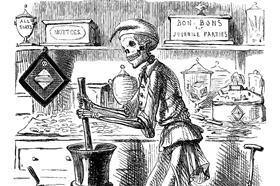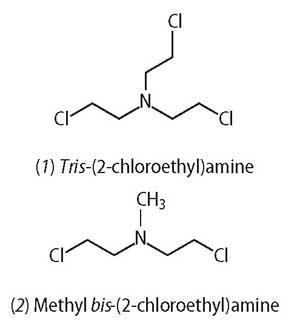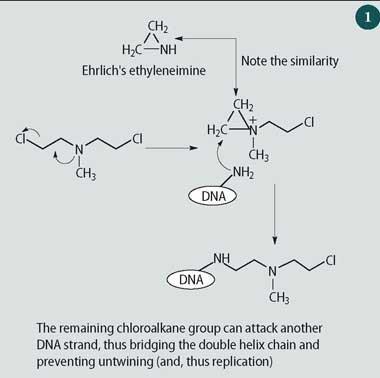Research and development of nitrogen mustards 60 years ago sets the scene for new era in the treatment of cancer.
-
Chemical warfare agent provides lead for Alfred Gilman's research into nitrogen mustards as potential anticancer agents
- By the mid-1950s sequential or combination therapy using combinations of anticancer agents shown to give better survival rates
"It is almost... as hard as finding some agent that will dissolve away the left ear... yet leave the right ear unharmed: so slight is the difference between the cancer cell and its normal ancestor."1

This was a view expressed in 1945 reflecting on the apparent incurability of cancer. It reiterates the view of Bernard Peyrilhe, a French chemist who was renowned for his pioneering experimental work into cancer. In 1776 Peyrilhe said that it was absurd even to look for a chemical agent that might differentiate between normal and malignant tissue: any agent damaging one, he said, was bound to damage the other.
There is, however, a long history of attempts to treat cancer with chemicals. The earliest is probably to be found in the Ebers papyrus of 1500 BC, which advocated using arsenical ointments to treat ulcerating, presumptively cancerous, lesions. Some later, allegedly highly successful, treatments are listed in Table 1.2 Their failure to stand the test of time indicates that, at best, the optimism of their proponents was unfounded.
Table 1 - An early chronology of cancer chemotherapy
| Date | Remedy | Comment |
| 1762 | Hemlock (impure coniine) | Claims provoke widespread scepticism but used well into 19th century |
| 1776 | Carbolic acid (phenol) | Used to treat nasal cancer |
| 1834 | Zinc chloride solid | Used to 'burn out' a tumour. Success rate of 82 per cent claimed |
| 1865 | Arsenic (Fowler's solution) | Used to treat leukaemia, but outcome not known |
| 1866 | Bromine | Used to 'burn out' cancer of the cervix |
| 1926 | Colloidal lead | Success rate of 14 per cent claimed |
War and peace research
In 1898, Paul Ehrlich, later famous for discovering the anti-syphilis drug Salvarsan,3 reported that the relatively simple molecule ethyleneimine destroys living tissue. He made little of this observation and no mention of any therapeutic potential. Indeed, a mechanism to explain its action would not emerge for half a century. The cancer treatment of the mid-1890s was radiotherapy and this, together with surgery, were to remain the only weapons to fight cancer for the next 50 years.
Some 20 years later Europe, embroiled in World War I, saw the use of mustard gas, bis -(2-chloroethyl) sulfide, added to the horrors of trench warfare (see Box 1). At first, the widespread blisters this molecule caused on the skin were thought to be the result of its absorption into the fat beneath the skin - hydrolysis by water in the tissues yielded hydrochloric acid and thus the blistering. It soon became apparent, however, that soldiers were dying from some more general action of mustard gas on the whole body. Edward Krumbhaar, an American pathologist, noticed that about two weeks after exposure, soldiers' bone-marrow cells would be destroyed. These cells produce the white blood cells that fight infections, so a markedly reduced number of these left patients vulnerable to opportunistic infections. Typically, they would contract pneumonia and not survive.
Box 1 - Mustard gas in warfare9
Mustard gas is neither a gas, nor does it smell of mustard. It is a high-boiling liquid, and when pure it has no odour. It is the presence of smelly impurities that gives it its name. Various chemists have been credited with the discovery of mustard gas, including Frederick Guthrie who reported its blistering (vesicant) action in 1859, having prepared it in an impure form by reacting ethene with SCl2. Victor Meyer, working at the University of Göttingen, devised a synthesis for the liquid in 1886 both in high yield and high purity.

With the advent of peace research into mustard gas continued in four areas:
- as a potential cancer-causing chemical. Very low doses caused a skin rash reminiscent of that induced by x-rays. Since x-rays were known to interfere with the normal process of cell division, scientists reasoned that mustard gas might do the same and thus cause cancer. This was to be confirmed by experiments, on fruit flies, during the 1940s;
- despite the Geneva Convention of 1925 banning the use of chemical weapons, the Allies investigated other agents related to mustard gas, in the hope of discovering even more dangerous chemicals to use against future enemies;
- alongside this research, presuming these potential enemies would also be developing chemical weapons, the Allies sought antidotes to the poisoning caused by mustard gas and its relatives to provide protection for their own forces;
- as a potential chemotherapeutic agent.
Research into the use of mustard gas as a therapeutic agent yielded one important paper in the inter-war years. James Ewing, a doctor serving in the US Army Medical Museum, wondered if dilute mustard gas solutions could be used to treat surface (skin) cancers. Frank Adair and Halsey Bagg, researchers in the Douglas Laboratory of the Memorial Hospital in New York, put his idea into practice. They applied tar to mice to induce skin cancer and then treated the lesions with dilute solutions of mustard gas. Usually the lesion disappeared after some scabbing and the mouse appeared cured.4 Encouraged by these results, Adair and Bagg applied their solution to 13 human patients, mainly suffering from some form of skin cancer:
The patient had a lesion 2.5 by 3 by 1 cm thick. Frequent applications were made to the lesion of small doses of the mustard gas. The tumour has been destroyed gradually and at present, four months after beginning treatment, there is no evidence of the disease and there is good healing over the site of the original tumour.
They sounded a note of caution:
"We fully recognise that this agent has been applied in our cases too recently for us to report cancer cures. But as it takes so many years to report cures, we are hoping that such a preliminary report may suggest possibilities to other investigators."4
We have been unable to find any follow-up studies to this apparently encouraging paper. We presume that the patients had their hopes dashed by a recurrence of their tumours, either locally or at distant sites.
Nitrogen mustards
Paradoxically, the next development was to come from the search for new chemical warfare agents. Nitrogen analogues of mustard gas, tris - and methyl bis -(2-chloroethyl)amines (structures (1) and (2)), the so-called nitrogen mustards, had been developed by the Pharmacology Section, Maryland Arsenal, US. Antidotes were being sought to block the action of these blister-causing agents (vesicants) in the bloodstream.

Sodium thiosulfate seemed promising, but a way of measuring its protective effect was needed. The research team, led by Alfred Gilman, an assistant professor in Yale's department of pharmacology, initially chose to monitor the rate of mustard gas-induced disappearance of lymphocytes (white blood cells) in rabbits. The next step was to use the agents on medical conditions associated with over-production of lymphocytes - initially experimental lymphoma (ie cancer that originates in the lymphocytes of the immune system) in mice. Success here might offer the hope of treating human lymphomas and even leukaemia (a cancer of the bone marrow, affecting the white blood cells).
A single mouse bearing a transplanted tumour was selected for investigation. An injection of an unspecified nitrogen mustard caused the tumour to soften and regress.5 Treatment was continued until the researchers believed that the mouse had been cured, but after a month, the tumour recurred. A second course of treatment was started, and regression again was observed, but this time it was not as complete as after the first regime. The animal lived some 84 days after transplantation of the tumour. This compared very favourably with the lifespan of a mouse with an untreated transplanted tumour - 21 days. Nothing had given a response like this.
Although the success was only partial, this observation led to clinical studies. A patient in the terminal stages of lymphosarcoma (a malignant cancer of the lymphoid system) was selected. His tumour had grown so large it was likely to affect both eating and breathing and the only action that might prolong his life (and then only briefly) would be to implant an artificial airway through his neck. He was treated with 0.1 mg kg(body mass)-1 of the intravenous tris nitrogen mustard daily for 10 days. Gilman reports:
"The response of the first patient was as dramatic as that of the first mouse... within 48 hours after the initial therapy a softening of the tumour masses was detected.... By the fourth day of treatment obstructive signs and symptoms were relieved... and by the 10th day (the) cervical masses were no longer palpable."6
But, as in the case of the mouse study, the improvement was only temporary. Gilman continues:
"As presaged by animal experiments. the tumour regenerated. A subsequent shorter course of therapy resulted in only transient improvement and a third course had little effect."6
Over 40 years later we can appreciate how accurately this first patient reflected the future trials and tribulations of therapy with alkylating agents. When the patient died, the tumour masses were relatively small. The drug was associated with a range of side effects that we still associate with chemotherapy such as prolonged vomiting and diarrhoea, but more seriously, it interfered with the production of white cells by the bone marrow. This reduced the patient's defences to such an extent that even infection with relatively benign bacteria could be fatal.
While the greater the dose of drug, the greater the chance of curing the cancer, this also increased the chance that the treatment itself would kill the patient. A balance had to be achieved. Nonetheless, Gilman had discovered a drug that could, metaphorically, dissolve away one ear leaving the other untouched. The problem was, it grew back.
Gilman's studies involved just two nitrogen mustards - the tris compound, and methyl-bis -(2-chloroethyl)amine. (The latter is still in use today, as part of a combined therapeutic regime.) What made Gilman pursue his studies with the nitrogen mustards when there had been some therapeutic success with mustard gas itself? Perhaps the choice was serendipitous - he and co-worker Frederick Philips were looking for antidotes to the nitrogen series and may have, fortuitously, also used these for their medical studies. Possibly anticipating this question, Gilman states that he discounted mustard gas studies because the sulfur-containing agent was too reactive (eg towards water) and therefore didn't lend itself to administration by injection or infusion.5 In contrast, the hydrochloride salts of his nitrogen mustards were water-soluble and dissolved easily in sterile saline for intravenous injection.
Sequential therapy
That Gilman's nitrogen mustards were effective, albeit only for a period, prompted others to seek alternative chemicals (both other mustard derivatives and different classes of compound) that induced longer remissions or even cure.
The next key advance in this line of research was by Dr Joe Burchenal of the Sloan-Kettering Research Institute. (This was later to unite with the Memorial Hospital where Adair and Bagley had worked, to form one of the leading cancer research and treatment hospitals of today, the Memorial Sloan-Kettering Hospital.) Burchenal's mouse studies showed that folic acid antagonists such as methotrexate or aminopterin could induce remission of transplanted leukaemias. He also found that a single large dose of cortisone could temporarily reduce the high leucocyte count, characteristic of these cancers.
Alongside this work, Burchenal investigated the use of 6-mercaptopurine (6MP) as an anti-leukaemia drug. Typically, children who had two-nine weeks of treatment with 6MP alone gained two-22 weeks of remission. When all three anticancer agents were used in a sequential programme, the results, reported in 1954, were dramatic (see Table 2).
Table 2 - Sequential therapy of acute leukaemia in children7
| Regime | Number of patients | Surviving one year or more/ per cent |
| No treatment |
218 |
5 |
| Folic acid antagonists/cortisone |
154 |
29 |
| Folic acid antagonists, cortisone and 6-mercaptopurine |
52 |
52 |
Thus from the mid-1950s, sequential or combination therapy became the standard model for chemotherapy to treat cancers, including lymphomas. In 1967 a combination of Gilman's methyl bis -(2-chloroethyl)amine, - mustine or mechlorethanamin - and the drugs oncovin, procarbazine, and prednisone (the MOPP regime) achieved remission rates over 80 per cent in the treatment of Hodgkin's lymphoma (human lymphoma). In contrast single drugs were relatively ineffective in treating this cancer, achieving remission rates of 20 per cent at best.8 While now displaced by even more effective combinations, MOPP remains an option when the current first line options are either ineffective or unsuitable.
Ehrlich's ethyleneimine
We now know cancers are caused by unregulated division of 'damaged' cells. Replication of DNA is crucial to this growth, in which the first step is the untwisting of the double helix of DNA. Mustine acts to prevent this untwisting, not directly, but through an intermediate highly reactive ammonium ion. Scheme 1 shows how this can form a link between the two strands of DNA, preventing them untwisting and so stopping cell division - and the growth of the cancer.9 The similarity between this ion and Ehrlich's ethyleneimine is not obvious, but is highlighted in Scheme 1. Ehrlich has long been credited with the first chemical treatment for an infective agent. It is intriguing to reflect that he came close to also developing the first chemical treatment for cancer.

The past 50 years have seen an explosive growth in the use and effectiveness of combination chemotherapy, often itself combined with either or both of surgery and radiotherapy. For example, the five-year relative survival rate for patients with Hodgkin's lymphoma was 86 per cent in 2002 for adults and 95 per cent for children, with further improvement expected from more recent treatment advances.10
Recent years have seen increasing sophistication in how chemotherapy is delivered. For example, some cancer cells have unique antigens on their cell surface, which means that antibodies can be developed against these. When chemotherapy drugs are linked to these antibodies, the chemotherapy can be delivered specifically to the cancer cells without damaging other healthy cells in the body. Herceptin, used to treat a particular type of breast cancer, is one example of such a drug. In defiance of Bernard Peyrilhe's observation over two centuries ago, it is no longer absurd to think of chemicals distinguishing between malignant and normal tissue.
Alan Dronsfield is emeritus professor of the history of science in the school of education, health and sciences at the University of Derby, Derby DE22 1GB. Peter Ellis is professor of psychological medicine in the school of medicine and health sciences at the University of Otago, Wellington, PO Box 7343, Wellington South, New Zealand.
Related Links
Lymphoma Information Network - Hodgkin's historical timeline of events
A timeline of events important in the history of Hodgkin's disease
Sulfur mustard - Wikipedia, the free encyclopedia
Article on the sulfur mustards, which includes description of the mode of action of sulfur mustard
Leukemia & Lymphoma Society
Hodgkin's lymphoma facts and statistics
References
- Quoted in M. Ochoa, Ann. New York Acad. Sci., 1969, 163, 921.
- B. MacGregor, Med. Hist., 1966, 10, 374.
- A. T. Dronsfield, P. M. Ellis and A. Battistini, Educ. Chem., 2004,41 (6), 162.
- F. E. Adair and H. J. Bagg, Ann. Surg., 1931, 93, 190.
- A. Gilman and F. S. Philips, Science, 1946, 103, 409.
- A. Gilman, Am. J. Surg., 1963, 105, 574.
- For good discussion of Burchenal's work see A. Thomas, Br. J. Haematology, 2006, 133, 493.
- Lymphoma Information Network website: Hodgkin's disease - historical timeline
- Wikipedia website: Adapted from mode of action of sulfur mustard
- Leukemia & Lymphoma Society website: Hodgkin's lymphoma facts and statistics






No comments yet